Introduction
When it comes to creating a functional and stylish walk-in closet, one of the key considerations is the dimensions of the space. The right dimensions can make a significant difference in how well your closet serves its purpose. In this article, we will explore the essential aspects of walk-in closet dimensions to help you design a space that meets both your storage needs and aesthetic preferences.
Assessing Available Space
Before diving into specific dimensions, it’s crucial to assess the available space for your walk-in closet. Measure the dimensions of the room accurately, taking into account any architectural features like alcoves or corners. This initial step lays the foundation for determining the ideal layout and size of your walk-in closet.
Standard Walk-In Closet Dimensions
While there’s no one-size-fits-all solution, certain standard dimensions can serve as a helpful starting point. A minimum width of 5 feet is recommended for a single-sided walk-in closet, allowing ample room for clothing racks or shelves. For a more spacious feel, consider widths of 7 to 10 feet, especially if you plan to include an island or seating area.
Height Considerations
The height of your walk-in closet is another critical factor. A standard ceiling height of 8 feet is common, but if your space allows, consider taller ceilings for a more luxurious atmosphere. Higher ceilings not only provide additional storage options but also contribute to an open and airy feel within the closet.
Designing Closet Zones
To optimize functionality, divide your walk-in closet into distinct zones. Allocate space for hanging items, shelving units, drawers, and accessories. Tailor the dimensions of each zone to accommodate the specific items you plan to store. For example, ensure there’s enough vertical space for full-length dresses or suits if needed.
The Importance of Depth
The depth of your walk-in closet determines how efficiently you can utilize the available space. A depth of 6 to 8 feet is generally suitable for most walk-in closets. This allows for comfortable access to items stored along the back wall while preventing the space from feeling cramped.
Island or Seating Area
If you have the luxury of space, consider incorporating an island or seating area into your walk-in closet. Islands can provide additional storage, while seating areas add a touch of luxury and practicality. Ensure that these elements fit comfortably within the overall dimensions, allowing easy movement around them.
Lighting and Ventilation
Beyond physical dimensions, consider the importance of lighting and ventilation. Adequate lighting is essential to help you see and organize your clothing effectively. Additionally, proper ventilation ensures a fresh and pleasant atmosphere within the closet. Incorporate fixtures strategically and, if possible, include windows or ventilation systems.
Customization Options
While standard dimensions provide a useful baseline, don’t hesitate to customize your walk-in closet based on your specific needs and preferences. Tailor the layout and dimensions to accommodate your wardrobe, whether you have a substantial shoe collection, numerous accessories, or specific storage requirements.
Conclusion
Designing the perfect walk-in closet involves a careful balance of dimensions, functionality, and personal style. By assessing your available space, considering standard dimensions, and customizing the layout to suit your needs, you can create a walk-in closet that not only organizes your belongings efficiently but also adds a touch of luxury to your daily routine. Take the time to plan thoughtfully, and you’ll enjoy a well-designed space that enhances both your storage capabilities and your overall home aesthetic.



